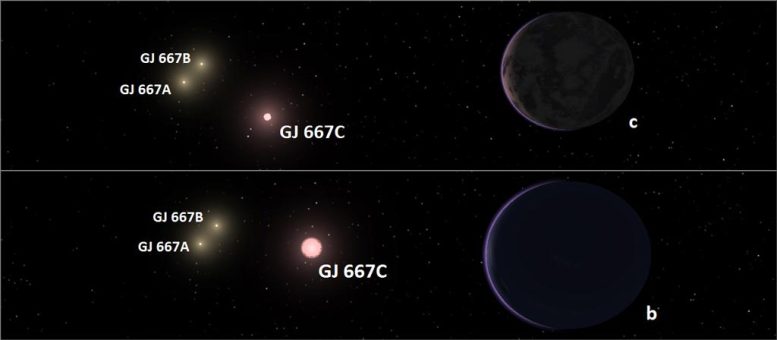
An artistic conception of the two planets reported on in this paper: b and c. Planet c is the one that lies in the habitable zone of the star. Planet b is too hot to be habitable. Credit: Guillem Anglada-Escudé
Using public data from the European Southern Observatory with measurements from the Keck Observatory’s High Resolution Echelle Spectrograph and the Carnegie Planet Finder Spectrograph at the Magellan II Telescope, a team of scientists discovered a potentially habitable super-Earth orbiting a nearby star. Further research needs to be conducted, but the scientists believe the surface temperatures could be similar to Earth.
An international team of scientists led by Carnegie’s Guillem Anglada-Escudé and Paul Butler has discovered a potentially habitable super-Earth orbiting a nearby star. The star is a member of a triple star system and has a different makeup than our Sun, being relatively lacking in metallic elements. This discovery demonstrates that habitable planets could form in a greater variety of environments than previously believed. Their work will be published by The Astrophysical Journal Letters.
The team used public data from the European Southern Observatory and analyzed it with a novel data analysis method. They also incorporated new measurements from the Keck Observatory’s High Resolution Echelle Spectrograph and the new Carnegie Planet Finder Spectrograph at the Magellan II Telescope.
Their planet-finding technique involved measuring the small wobbles in a star’s orbit in response to a planet’s gravity. Anglada-Escudé and his team focused on an M-class dwarf star called GJ 667C, which is 22 light-years away. It is a member of a triple-star system. The other two stars (GJ 667AB) are a pair of orange K dwarfs, with a concentration of heavy elements only 25% that of our Sun’s. Such elements are the building blocks of terrestrial planets so it was thought to be unusual for metal-depleted star systems to have an abundance of low-mass planets.
GJ 667C had previously been observed to have a super-Earth (GJ 667Cb) with a period of 7.2 days, although this finding was never published. This orbit is too tight, and thus hot, to support life. The new study started with the aim of obtaining the orbital parameters of this super-Earth.
But in addition to this first candidate, the research team found the clear signal of a new planet (GJ 667Cc) with an orbital period of 28.15 days and a minimum mass of 4.5 times that of Earth. The new planet receives 90% of the light that Earth receives. However, because most of its incoming light is in the infrared, a higher percentage of this incoming energy should be absorbed by the planet. When both these effects are taken into account, the planet is expected to absorb about the same amount of energy from its star that the Earth absorbs from the Sun. This would allow surface temperatures similar to Earth and perhaps liquid water, but this extreme cannot be confirmed without further information on the planet’s atmosphere.
“This planet is the new best candidate to support liquid water and, perhaps, life as we know it,” Anglada-Escudé said.
The team notes that the system might also contain a gas-giant planet and an additional super-Earth with an orbital period of 75 days. However, further observations are needed to confirm these two possibilities.
“With the advent of a new generation of instruments, researchers will be able to survey many M dwarf stars for similar planets and eventually look for spectroscopic signatures of life in one of these worlds.”
Reference: “A Planetary System Around the Nearby M Dwarf GJ 667C With at Least One Super-Earth in Its Habitable Zone” by Guillem Anglada-Escudé, Pamela Arriagada, Steven S. Vogt, Eugenio J. Rivera, R. Paul Butler, Jeffrey D. Crane, Stephen A. Shectman, Ian B. Thompson, Dante Minniti, Nader Haghighipour, Brad D. Carter, C. G. Tinney, Robert A. Wittenmyer, Jeremy A. Bailey, Simon J. O’Toole, Hugh R. A. Jones and James S. Jenkins, 3 May 2012, The Astrophysical Journal Letters.
DOI: 10.1088/2041-8205/751/1/L16
Anglada-Escudé was with Carnegie when he conducted the research, but has since moved on to University of Gottingen. His co-authors are Carnegie’s Butler, Jeffrey D. Crane, Stephen A. Shectman, and Ian B. Thompson; Pamela Arriagada and Dante Minniti of Pontificia Universidad Catolica de Chile; Steve Vogt and Eugenio J. Rivera of University of California’s Lick Observatory; Nader Haghighipour of the Institute for Astronomy & NASA Astrobiology Institute at University of Hawaii-Monoa; Brad D. Carter of University of Southern Queensland; C. G. Tinney, Robert A. Wittenmyer, and Jeremy A. Bailey of the University of New South Wales; Simon J. O’Toole of the Australian Astronomical Observatory; Hugh R.A. Jones of the University of Hertfordshire; and James S. Jenkins of the Universidad de Chile, Camino El Observatorio.


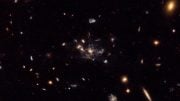
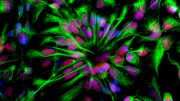
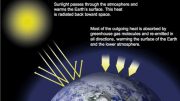
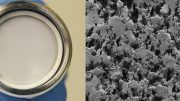
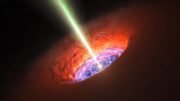
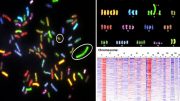

Be the first to comment on "Team of International Scientists Discover New Super-Earth"